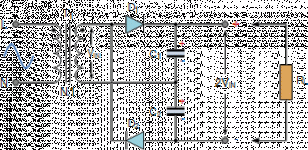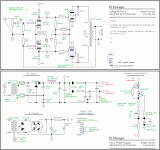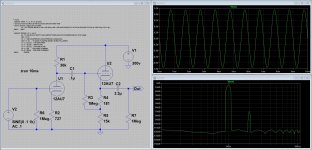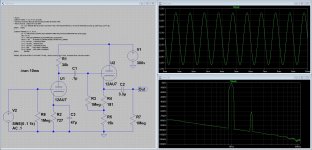Planning on building something like this and would like your thoughts on the design. Based on the load lines it appears solid.
DIY 12AU7 Tube preamp
I'd like to use this to drive a TPA 3116 amp that I just got in the mail from eBay for $7. Can't believe how good this sounds driving my Klipsch Forte's. I can only barely crack the volume control for plenty of level.
I've got a few tubes laying around and looking to build something after a long absence from audio DIY. About 20 years ago I built a couple of 300b amps and other stuff.
I'd like to purchase a 12 volt switching supply for the amp and tube filaments and a boost converter for the plate voltage. Such things were not even available back then.
DIY 12AU7 Tube preamp
I'd like to use this to drive a TPA 3116 amp that I just got in the mail from eBay for $7. Can't believe how good this sounds driving my Klipsch Forte's. I can only barely crack the volume control for plenty of level.
I've got a few tubes laying around and looking to build something after a long absence from audio DIY. About 20 years ago I built a couple of 300b amps and other stuff.
I'd like to purchase a 12 volt switching supply for the amp and tube filaments and a boost converter for the plate voltage. Such things were not even available back then.
It is unlikely line stage gain is needed, when the signal source is a CDP or other modern digital device.
The 12AU7 contains non-linear triodes. As such, the type makes a poor voltage amplifier. Given 100% local current NFB, the 'U7 is OK in the cathode follower role.
If you really need line stage gain, the linked PCB will work fine, with 12BH7s populating the sockets. You will need double the heater current.
I'm old fashioned, sue me. I prefer linear PSUs. You will get ALL (100+ mA.) the B+ you need by "full wave" voltage doubling the O/P of an inexpensive Triad N-68X isolation trafo.
The 12AU7 contains non-linear triodes. As such, the type makes a poor voltage amplifier. Given 100% local current NFB, the 'U7 is OK in the cathode follower role.
If you really need line stage gain, the linked PCB will work fine, with 12BH7s populating the sockets. You will need double the heater current.
I'm old fashioned, sue me. I prefer linear PSUs. You will get ALL (100+ mA.) the B+ you need by "full wave" voltage doubling the O/P of an inexpensive Triad N-68X isolation trafo.
Attachments
Thanks for the great reply Eli. I admit I don't need a gain stage. I want to hear what this amp sounds like with a tube front end. And good call on the power supply. Could that same transformer and voltage doubler be OK for a tube amplifier, not just a preamp?
Last edited:
Cathode Follower curves are a bit different....since the CF input signal is actually applied between grid and plate.... When I use this type of line-stage ..I direct couple the 1st Gain stage to the 2nd stage CF...
Thanks for the great reply Eli. I admit I don't need a gain stage. I want to hear what this amp sounds like with a tube front end. And good call on the power supply. Could that same transformer and voltage doubler be OK for a tube amplifier, not just a preamp?
100 mA. at roughly 300 V. will support a 5 WPC stereoblock using SE pentode or UL mode "12" W. types, like the EL84 and 6V6. We used the N-68X's "big brother", the N-77U, in "El Cheapo". That "iron" is good for a bit more than 200 mA. of B+.
For your tube front end, dig into the archives for 12B4 based designs. There's some gain, but the kind of attenuating that fouls S/N performance up is not needed. It's hard to think of μ 20ish tubes as having too much gain, but it's true given up to 2 VRMS at the I/P. A great thing about the 12B4 is its rare ability to drive the 10 Kohm IHF "standard" load, when wired common cathode.

Attachments
Last edited:
Hello Eli,
While I generally appreciate your posts in various forums, I fail to understand your dislike of the poor 12AU7, as you only substanciate this with the sentence "The 12AU7 contains non-linear triodes", always.
This particular case opens a nice opportunity for testing: I simulated Shine7's circuit, with the results and the LTspice file attached. As you can see, they are very consistent with the original author's measurements, which I believe are done on a physical circuit.
I've also seen some attempt to explain this dislike by another poster, who used some plate curves math to justify his point, but he was talking about many ten's of volts instead of 1 volt max for a preamp.
AFAIK, -70dB of H2 in a tube circuit never hurts anyone. Any thoughts?
While I generally appreciate your posts in various forums, I fail to understand your dislike of the poor 12AU7, as you only substanciate this with the sentence "The 12AU7 contains non-linear triodes", always.
This particular case opens a nice opportunity for testing: I simulated Shine7's circuit, with the results and the LTspice file attached. As you can see, they are very consistent with the original author's measurements, which I believe are done on a physical circuit.
I've also seen some attempt to explain this dislike by another poster, who used some plate curves math to justify his point, but he was talking about many ten's of volts instead of 1 volt max for a preamp.
AFAIK, -70dB of H2 in a tube circuit never hurts anyone. Any thoughts?
Attachments
Zung, bypass the cathode resistor with a 47u capacitor and check the distortion again, you used cathode degeneration to linearise the tube, thus lowering distortion.
12AU7 are great as cathode followers
Silviu
12AU7 are great as cathode followers
Silviu
What would be the point of doing that, when the circuit that was proposed has an unbypassed resistor?
Nothing wrong with building a circuit where the designer is offering measured performance data. I SO wish more tube neophytes would do that! So much bull flying around.
There may be a lot better choices out there, but if you picked 12AU7 for a good reason, then it's a good circuit. If you want to open up your selection to NOS, Russian, Chinese, etc. tubes you would probably land somewhere else.
Nothing wrong with building a circuit where the designer is offering measured performance data. I SO wish more tube neophytes would do that! So much bull flying around.
There may be a lot better choices out there, but if you picked 12AU7 for a good reason, then it's a good circuit. If you want to open up your selection to NOS, Russian, Chinese, etc. tubes you would probably land somewhere else.
All thermionic devices are non-linear. They follow Child's Law, its the basic physics of space-charge in a vacuum - there's nothing special about the 12AU7.Hello Eli,
While I generally appreciate your posts in various forums, I fail to understand your dislike of the poor 12AU7, as you only substanciate this with the sentence "The 12AU7 contains non-linear triodes", always.
The output signal amplitude is 0.3% of the supply voltage, which is why the distortion is so low - for a 100V output signal the distortion would be very significant.This particular case opens a nice opportunity for testing: I simulated Shine7's circuit, with the results and the LTspice file attached. As you can see, they are very consistent with the original author's measurements, which I believe are done on a physical circuit.
Yup, its small signal amplitude that keeps the distortion down - the device is fundamentally non-linear though, as its thermionic.I've also seen some attempt to explain this dislike by another poster, who used some plate curves math to justify his point, but he was talking about many ten's of volts instead of 1 volt max for a preamp.
AFAIK, -70dB of H2 in a tube circuit never hurts anyone. Any thoughts?
Member
Joined 2009
Paid Member
The 12AU7 is a popular choice because it does well at low plate voltages and that's nice for people who are not familiar with the safety requirements of high voltages, or who are building hybrid circuits and would like to use available low voltage supplies. The 12AU7 has relatively low grid current when used at low voltages as compared with similar tubes. It's commonly available, has reasonable heater-demands and the transconductance, which is important for CF applications, is at least average (if you want tube-sound you don't want the transconductance to be too high anyhow).
Zung, bypass the cathode resistor with a 47u capacitor and check the distortion again, you used cathode degeneration to linearise the tube, thus lowering distortion.
12AU7 are great as cathode followers
Silviu
Good point, but no big deal, just a tad more H2 at about -62dB.
BTW, I forgot to include a required line for the Koren model:
.MODEL DX D(IS=1N RS=1 CJO=10PF TT=1N)
All thermionic devices are non-linear. They follow Child's Law, its the basic physics of space-charge in a vacuum - there's nothing special about the 12AU7...
Makes sense.
The 12AU7 is a popular choice because it does well at low plate voltages and that's nice for people who are not familiar with the safety requirements of high voltages, or who are building hybrid circuits and would like to use available low voltage supplies. The 12AU7 has relatively low grid current when used at low voltages as compared with similar tubes. It's commonly available, has reasonable heater-demands and the transconductance, which is important for CF applications, is at least average (if you want tube-sound you don't want the transconductance to be too high anyhow).
I'd add the low Mu which makes it perfect for a line stage as is the case being discussed.
Attachments
Member
Joined 2009
Paid Member
I'd add the low Mu which makes it perfect for a line stage as is the case being discussed.
For a cathode follower the mu is not usually a factor but in the case of a hybrid system with lower voltages the lower mu implies a larger separate between the grid and cathode which in turn helps reduce grid current to maintain a high input impedance and headroom.
My line stage has a gain of 10. I'm using 6N14P for it. I only use 12AU7 for light duty shunt regulation like in Broskie's Janus.
Member
Joined 2009
Paid Member
Interesting, I haven't seen many folk using the Janus regulator. These regulators performance depends strongly on the regulator tube transconductance ?
From the bottom of Passive and Active Shunt Regulators
"Finally, we arrive at the circuit that I wanted to start with, but that I feared would not make sense without some mind stretching first. The circuit below makes use of both the feedforward shunt regulation and conventional feedback-based shunt regulation. The 12AX7 both voltage divides the raw power supply ripple and amplifies the output perturbations. The 12AU7 both shunts away the power supply ripple and the load-induced noise on the output. the only thing missing is the protection diode that should span from the 12AX7’s plate to the 12AU7’s cathode, which would limit the maximum positive grid-to-cathode voltage on the 12AU7 to less than 1V."
I use one per channel in my phono amp 🙂
"Finally, we arrive at the circuit that I wanted to start with, but that I feared would not make sense without some mind stretching first. The circuit below makes use of both the feedforward shunt regulation and conventional feedback-based shunt regulation. The 12AX7 both voltage divides the raw power supply ripple and amplifies the output perturbations. The 12AU7 both shunts away the power supply ripple and the load-induced noise on the output. the only thing missing is the protection diode that should span from the 12AX7’s plate to the 12AU7’s cathode, which would limit the maximum positive grid-to-cathode voltage on the 12AU7 to less than 1V."
I use one per channel in my phono amp 🙂
Member
Joined 2009
Paid Member
- Status
- Not open for further replies.
- Home
- Amplifiers
- Tubes / Valves
- 12AU7 Cathode Follower Preamp



